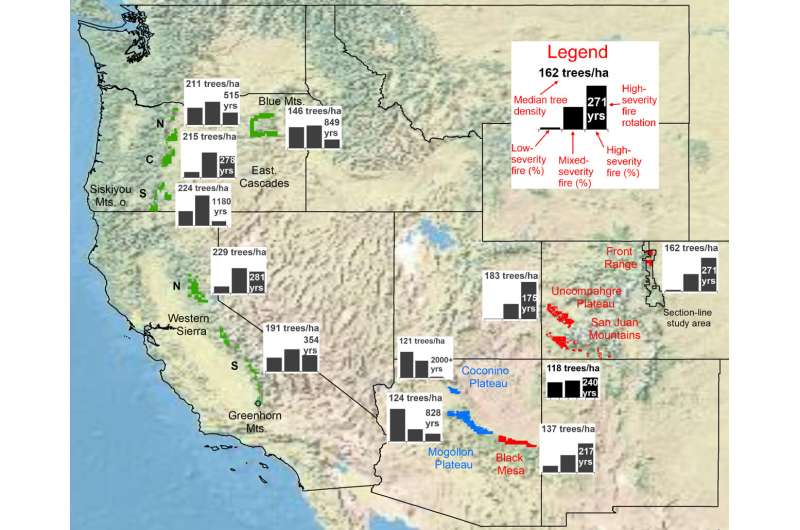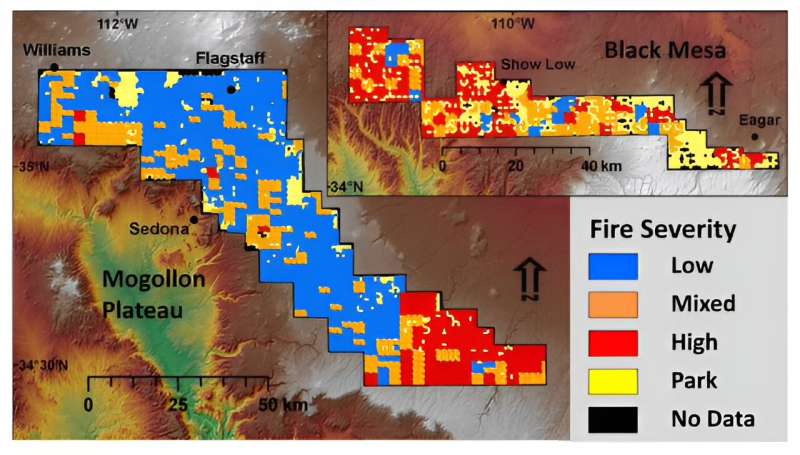by William L. Baker, Chad T. Hanson, Mark A. Williams and Dominick A. DellaSala
Evidence of forest structure and fires in pre-industrial dry forests—major forests covering ~26 million hectares (64 million acres) of the western U.S.—provides an essential historical baseline. Dry forests are dominated by ponderosa pine (Pinus ponderosa) or similar pines, and mixtures of these pines with other trees.
Wildfires in dry forests are now increasing and spilling over into communities, leaving questions about how natural these fires are and what should be done to prevent them. We presented extensive evidence in a recently published review in the journal Fire (1), which demonstrated that a synthesis by Hagmann et al (2021) (2), which promoted extensive forest manipulation to reduce high-severity fires, omitted a large body of evidence about pre-industrial forests and drew false conclusions.
Federal agencies have been spending billions to thin forests, suppress fires, and increase prescribed burning to reduce fuels and limit high-severity fires that they believe they have shown, in publications, are generally unnatural. Some evidence supports their “low-severity” model of historical fires in dry forests, in which frequent low-severity fires, not severe enough to kill many overstory trees, are thought to have kept dry forests generally open, with little fuel, favoring older trees, largely prevented high-severity fires.
However, since the 1990s, we and other scientists have published numerous studies documenting historically infrequent (e.g., every 200–800 years) pre-industrial high-severity fires, including large high-severity patches, as well as more variability in fires and tree density in dry forests. These two models have been actively contested for about three decades even though agencies have generally adopted the low-severity model and used it to justify large funding and extensive forest manipulation.
It is common to hear from land managers, politicians and even some environmental organizations that our forests are “out of whack” and overgrown, so they must be thinned (logged) to prevent unnatural high-severity fires. Some management changes are needed if the goal is to restore forests using pre-industrial forests as a guide, but this low-severity model and suite of management actions is not valid.
In our recent review in the international journal Fire, we showed why the conclusions of the prior review paper by Hagmann et al promoting the low-severity model are rejected due to omitted and false evidence. We showed that a very large body of published historical evidence that refutes the low-severity model was omitted in the Hagmann study, including hundreds of direct observations and accounts by early scientists, land surveyors and early newspaper accounts, as well as evidence over large land areas from early oblique and aerial photographs, agency forest atlases, and agency inventories.
Also omitted was extensive evidence in many published scientific reconstructions from paleo-charcoal, tree rings, and 15 landscapes covering >2.9 million ha (7 million acres) with detailed, late-19th-century land surveys. These allowed reconstruction of historical tree density, the percentages of fires by severity, and the estimated rates of high-severity fires.

Fifteen large landscapes with US General Land Office survey reconstructions of pre-industrial tree density (trees/ha > 10 cm diameter), percentages of fires by severity, and high-severity fire rotations (estimated period to burn once across a land area equal to the study area) © Fire (2023). DOI: 10.3390/fire6040146
Some of this omitted evidence was actually published by authors of the study, who even omitted their own evidence. Their review also drew the false conclusion that recent high-severity fires are burning at rates that exceed historical baseline rates, but only three of 14 studies they cited had adequate data, and the three actually showed that recent high-severity fires are burning at or below historical rates. They also omitted the largest published study of this question, for all dry forests, which also showed that recent high-severity fires are not burning at rates that exceed their historical rates (3).
Our review in Fire shows that correction of this large body of omitted and false evidence in the article by Hagmann et al rejects the low-severity model of historical fire and forests over nearly all dry forests, and instead supports the mixed-severity model for these forests.
There were some smaller areas, particularly in the southwestern U.S., where low-severity fire dominated and high-severity fires were rare over extended periods, but even these smaller areas had infrequent, higher-severity fires that burned over extensive land areas. For example, the early land surveys analyzed by two of us (4) showed that much of the Mogollon Plateau in Arizona historically had large areas of low- to mixed-severity fires adjacent to a southerly area on the same plateau and the adjoining Black Mesa, which had large areas of forests with abundant evidence of mixed- and high-severity fires.

Pre-industrial (historical) fire severity, reconstructed from General Land Office surveys for the Mogollon Plateau, northern Arizona, and the adjoining Black Mesa. © Global Ecology and Biogeography (2012). DOI: 10.1111/j.1466-8238.2011.00750.x
What does this rejection of the low-severity model mean for management in today’s forests? From an ecological standpoint, mechanically reducing fuels and suppressing high-severity fires are inappropriate in dry forests except for protection near buildings and infrastructure, since high-severity fires are not burning at rates that exceed pre-industrial rates.
The primary ecological restoration need is just to increase low- to moderate-severity fires in these forests, which have been and still are often suppressed, adding to the fire deficit in dry forests. Slowing or stopping suppression of natural fires would more naturally restore dry forests and adapt them to future fire and climate change. Agencies have adopted federal policy (5) that allows more natural ignitions to be managed for resource benefit, but agencies commonly bow to intense community and political pressure and congressional funding that demands suppression.
Nevertheless, with further climate change, wildfire ignitions that escape suppression will eventually close the fire deficit regardless of what managers do, unfortunately with increasing consequences to unprepared built environments. We think a better approach is focusing on home-ignition prevention, cutting emissions across all sectors including forestry, and concentrating suppression on community protection to facilitate more coexistence with wildfire.
This story is part of Science X Dialog, where researchers can report findings from their published research articles. Visit this page for information about ScienceX Dialog and how to participate.
More information:
1. William L. Baker et al, Countering Omitted Evidence of Variable Historical Forests and Fire Regime in Western USA Dry Forests: The Low-Severity-Fire Model Rejected, Fire (2023). DOI: 10.3390/fire6040146
2. R. K. Hagmann et al, Evidence for widespread changes in the structure, composition, and fire regimes of western North American forests, Ecological Applications (2021). DOI: 10.1002/eap.2431
3. William L. Baker et al, Are High-Severity Fires Burning at Much Higher Rates Recently than Historically in Dry-Forest Landscapes of the Western USA?, PLOS ONE (2015). DOI: 10.1371/journal.pone.0136147
4. Mark A. Williams et al, Spatially extensive reconstructions show variable-severity fire and heterogeneous structure in historical western United States dry forests, Global Ecology and Biogeography (2012). DOI: 10.1111/j.1466-8238.2011.00750.x
5. National Cohesive Wildland Fire Management Strategy: www.forestsandrangelands.gov/s … gy/thestrategy.shtml
Dr. William L. Baker is Emeritus Professor, Program in Ecology, University of Wyoming, Laramie, WY. Dr. Chad T. Hanson is Director and Chief Ecologist with the John Muir Project of Earth Island Institute, Berkeley, California. Dr. Mark A. Williams was a PhD student in the Program in Ecology, University of Wyoming, Laramie, WY and is now a resident of Salt Lake City, UT. Dr. Dominick A. DellaSala is Chief Scientist at Wild Heritage, a Project of Earth Island Institute, Berkeley, California.
Citation:
Countering false and omitted evidence of historically heterogeneous western US dry forests and mixed-severity fires (2023, August 14)



